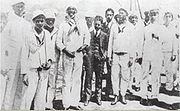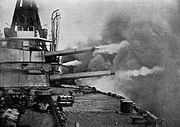
Revolt of the Whip
Encyclopedia

Rio de Janeiro
Rio de Janeiro , commonly referred to simply as Rio, is the capital city of the State of Rio de Janeiro, the second largest city of Brazil, and the third largest metropolitan area and agglomeration in South America, boasting approximately 6.3 million people within the city proper, making it the 6th...
, Brazil
Brazil
Brazil , officially the Federative Republic of Brazil , is the largest country in South America. It is the world's fifth largest country, both by geographical area and by population with over 192 million people...
. Despite the two-year organization and strategies of the movement against the lash, the mostly black crews of four Brazilian warships, led by João Cândido Felisberto
João Cândido Felisberto
João Cândido Felisberto was a Brazilian sailor, best known as the leader of the "Revolt of the Whip." In the 1930s, he became an integralist.-Early life:...
, mutinied on 22 November, shortly after a sailor publicly received 250 lashes. The crews deposed their white officers and threatened to bombard Rio de Janeiro. The mutiny was resolved within a week, with an amnesty that the Brazilian Government then did not honour. Consequently, a climate of unrest lasted for months. The navy discharged 2000 sailors and government forces (Police, Army, Navy, etc) killed hundreds of them, but this was the last occasion on which the Brazilian navy used the lash.
Background
Soon after the dreadnoughtDreadnought
The dreadnought was the predominant type of 20th-century battleship. The first of the kind, the Royal Navy's had such an impact when launched in 1906 that similar battleships built after her were referred to as "dreadnoughts", and earlier battleships became known as pre-dreadnoughts...
Minas Geraes arrived in Brazil, a severe depression
Depression (economics)
In economics, a depression is a sustained, long-term downturn in economic activity in one or more economies. It is a more severe downturn than a recession, which is seen by some economists as part of the modern business cycle....
hit the Brazilian economy. The economic hardship, the racism prevalent in all branches of the Brazilian armed forces, and the severe discipline enforced on all navy ships spawned a mutiny, known as the "Revolt of the Lash", among sailors on the major warships.
Many of the black sailors on Minas Geraes were slaves freed under the Lei Áurea
Lei Áurea
The Lei Áurea , adopted on May 13, 1888, was the law that abolished slavery in Brazil.It was preceded by the Rio Branco Law of September 28, 1871 , which freed all children born to slave parents, and by the Saraiva-Cotegipe Law , of September 28, 1885, that freed slaves when they reached the age of...
, or their sons. They were forced to enter the navy, where they faced wide-spread discrimination. It was common for officers to direct "racial abuse and physical violence" at the sailor; the sailors could not escape this abuse because they were required to serve for 15 years. Officers were quick to administer punishment with "leather whips tipped with metal balls" for even minor infractions. Early in 1910, black sailors unhappy with their situation began planning an uprising; they chose João Cândido Felisberto — an experienced sailor later known as the "Black Admiral" — as their leader.
In mid-November, a sailor received a sentence of 250 strokes of the whip, in front of his fellow sailors, even though the practice had been banned by law. The punishment continued even after the sailor fainted. The incident infuriated the nascent mutineers; they were not ready and could not revolt immediately, but they quickened their preparations.
Mutiny
The sailors on Minas Geraes rebelled on 21–22 November, earlier than originally planned. They murdered several officers and the captain; other officers they forced off the ship. They also kept British engineers who had sailed with the ship since its completion as hostages.The revolt spread to São Paulo
Brazilian battleship Sao Paulo
São Paulo was a dreadnought battleship designed for the Brazilian Navy by the British company Armstrong Whitworth. She was the second of two ships in the Minas Geraes class, and was named after the state and city of São Paulo....
, the older coastal defense ship Deodoro, and the new cruiser
Cruiser
A cruiser is a type of warship. The term has been in use for several hundreds of years, and has had different meanings throughout this period...
Bahia
Brazilian cruiser Bahia
Bahia was the lead ship of a two-vessel class of cruisers built for Brazil by Armstrong Whitworth in the United Kingdom. Six months after her commissioning , crewmen aboard Bahia, , , and mutinied, beginning the...
. During this time, discipline remained tight on the ships undergoing mutiny; daily drills were conducted and Cândido ordered all liquor
Alcohol
In chemistry, an alcohol is an organic compound in which the hydroxy functional group is bound to a carbon atom. In particular, this carbon center should be saturated, having single bonds to three other atoms....
to be thrown overboard.

National Congress of Brazil
The National Congress of Brazil is the legislative body of Brazil's federal government.Unlike regional legislative bodies – Legislative Assemblies and City Councils -, the Congress is bicameral, composed of the Federal Senate and the Chamber of Deputies .The Senate represents the 26 states and...
to give in to the rebels' demands.
The demands included the abolition of flogging, improved living conditions, and the granting of amnesty
Amnesty
Amnesty is a legislative or executive act by which a state restores those who may have been guilty of an offense against it to the positions of innocent people, without changing the laws defining the offense. It includes more than pardon, in as much as it obliterates all legal remembrance of the...
to all mutineers. The government also issued official pardons and a statement of regret.
Its submission resulted in the rebellion's end on 26 November, when the mutineers returned control of the four ships to the navy. However, the government passed a decree on 28 November that allowed the Minister of the Navy to expel any sailor who was "undermining discipline"; many sailors saw this act as a repudiation of their amnesty. Many were jailed and tortured. João Cândido himself was held at Hospital de Alienados (hospital for the insane).
Two weeks after the conclusion of the Revolt of the Lash, the marine garrison of the naval base of Ilha das Cobras
Ilha das Cobras
Ilha das Cobras is an island located within Guanabara Bay in the city and state of Rio de Janeiro, Brazil....
also mutinied. This mutiny the government quickly suppressed.
Aftermath
Thirty-nine years after his death from cancer in Hospital Getúlio Vargas, Rio de Janeiro, João Cândido and others were given the amnesty that had been promised and then denied when on 24 July 2008 the Congress reaffirmed the 25 November 1910 legislative act granting amnesty. The revolt was cited later by labor organizers as an "heroic example of worker struggle". A statue of João Cândido Felisberto was erected overlooking the Ilha das CobrasIlha das Cobras
Ilha das Cobras is an island located within Guanabara Bay in the city and state of Rio de Janeiro, Brazil....
in Rio de Janeiro
Rio de Janeiro
Rio de Janeiro , commonly referred to simply as Rio, is the capital city of the State of Rio de Janeiro, the second largest city of Brazil, and the third largest metropolitan area and agglomeration in South America, boasting approximately 6.3 million people within the city proper, making it the 6th...
.
Further reading
- Morel, Edmar. A Revolta da Chibata. Rio de Janeiro: Pongetti, 1959. .
- Martins, Hélio Leôncio, A Revolta dos Marinheiros, 1910. Rio de Janeiro. Revista Naval..

